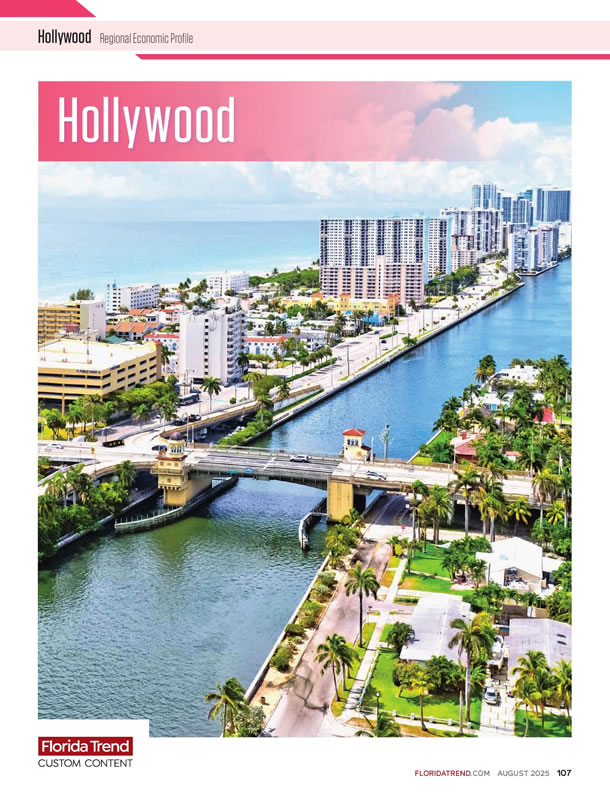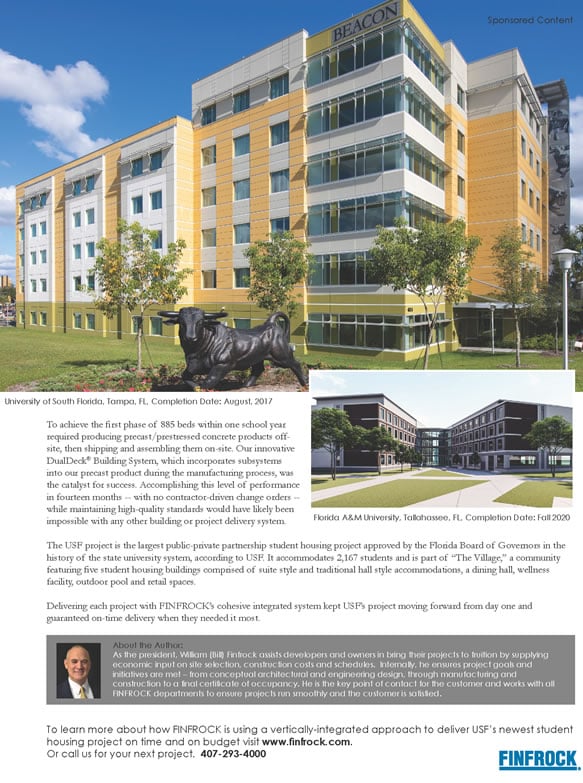Ever since Ponce de Leon's search for the fountain of youth, water has been Florida's biggest attraction. Long before there was Disney World, Florida had palm trees and sandy beaches, sailboats, surfing, and cheesy postcards of smiling alligators and inviting women.
Burt Reynolds, Sylvester Stallone, Madonna, Oprah Winfrey, Whitney Houston and Sophia Loren all own waterfront houses or condos in Florida. And our firm's research shows that almost everyone who thinks about moving to Florida wants to live on the water - even lots on a manmade lake, a canal or a golf course water hole command strong premiums.
Unfortunately, there's not enough waterfront property to go around for traditional single-family homes. But a growing array of condos should meet the steady demand for beach living.
Florida mystique
For 13 years, Cape Cod retirees Marge and Marvin Blank have spent winters in Hollywood, Florida, a block from the ocean. Next year, they'll move to a two-bedroom oceanfront condo at Renaissance on the Ocean, a 104-unit development between the ocean, a county park and a nature preserve. "Being on the beach will be a lot better than having to walk across A1A," says Marvin Blank.
The number of empty nesters is rising rapidly in Florida, and a healthy real estate market in the Northeast and Midwest is allowing more pre-retirees and retirees to buy second homes on the waterfront.
Changing demographics also drive the market. More people are staying single into their 30s, and many young married couples are waiting longer to have children. "It's not unusual for a couple in their 30s to make a significant investment in a waterfront home," says Mary Ann McArthur, vice president, Prudential Florida's Bellair office in Pinellas County.
Baby-boomers who grew up with the Florida mystique have accumulated enough wealth to afford a waterfront home on the St. Johns River or a spacious condo on Key Biscayne or a luxurious mansion on the gulf.
For all these groups, "Waterfront homes are the ultimate end of the move-up market," says Richard Cope, chairman and CEO, Prudential Florida Realty in Clearwater. "Many people move to Florida, then decide they have to live on the water."
Also, more Canadians, Europeans, Asians and Latin Americans have discovered the Florida lifestyle, and they are strong forces in waterfront markets around the state. Generally, Canadians are a major factor in Pinellas County; Europeans flock to Manatee and Sarasota counties; while Brazilians, Venezuelans and Colombians buy second homes in Dade County, according to Cope.
In Dade County, about 20% of luxury waterfront condominiums are purchased by Canadians and Europeans, and 40% are bought by Latin Americans. Many south Florida developers have foreign ties. For example, Italian Ugo Colombo is building the 54-story Santa Maria on Biscayne Bay. On South Beach, Brazilians are developing Il Villaggio and a French firm is building 1500 Ocean. On Miami Beach, a German group is responsible for Oceania, and a Venezuelan developer is building Millennium in Sunny Isles.
In today's market, a potential waterfront buyer has several choices:
- Buy a new spec home on an individual waterfront lot or find a vacant lot and build a custom home.
- Pay a premium price for an older single-family property in a developed community, tear down the existing house and build anew.
- Look for more moderately priced property in smaller and relatively undeveloped communities far from Florida's big urban centers.
- Purchase a townhouse and enjoy some of the advantages of a single-family home, such as a garage and ground-floor patio or yard.
- Go vertical, by purchasing a condominium residence in either a new mid-rise or high-rise complex, or seek out a bargain in a resale unit.
Single-family homes
Whenever a potential buyer asks JW Diuguid, broker-salesperson, Real Estate Professionals of Destin, about waterfront single-family homes in the Panhandle, the first thing she does is outline the pecking order.
"Beachfront property directly on the Gulf of Mexico is the most expensive," she says. Homes run from $300,000 to more than $1 million. Next on the list are waterfront properties with deep-water boat dockage, where prices are roughly half of beachfront lots. "Destin is a fisherman's paradise, and everyone likes great big boats," Diuguid says. "Accessibility to the gulf is another factor. Deep-water bayou frontage is priced based on how big a boat can be accommodated and how far it is to the gulf." Further down the list are bayfront homes where the water is too shallow for boats; then come lakes or canals without access to the bay or gulf.
The same pricing hierarchy applies throughout Florida: oceanfront, Intracoastal Waterway, rivers, lakes and canals. In Jacksonville, for instance, homes on the St. Johns River start at about $300,000 and homes on the ocean run to well over $1 million, according to John Neighbors of Watson Realty's Mandarin office. "We sell a lot of homes on the St. Johns River," he says. "Everybody in Jacksonville wants to live on the water, and prices are rising at least 10% a year."
In southwest Florida, a growing number of corporate executives and international buyers have discovered Naples and Fort Myers. Many buyers are "captains of industry" at the peak of their careers, says Charles Richardson, office manager, Prudential Florida Realty, Naples. "While Naples still draws a lot of retirement-age buyers, these executives are redefining the pricing structure."
The allure of water applies even to Orlando and central Florida, where lakes are the draw. For example, five custom builders recently unveiled their "Street of Dreams" at Phillips Landing, a string of 5,500-square-foot, $1 million homes along Big Sand Lake in southwest Orlando.
Soaring prices
With demand for waterfront homes coming from all market sectors, prices have risen dramatically in the 1990s. A decade ago, it was rare to pay $200 a square foot. Now, buyers are paying $275 and more than $400 a square foot at ultra-luxury projects like Fisher Island in Miami Beach and the Presidential in Boca Raton.
Waterfront single-family homes have been appreciating at 10% a year or more in most major markets - two or three times as fast as "dry" homes, according to Florida real estate agents. In hot markets like Naples and Fort Lauderdale, waterfront homes have risen 30% to 35% in the last two years, compared with 5% for nonwaterfront homes, says Cope. In Destin, Diuguid recently sold for $985,000 a lot on the Gulf of Mexico that went for $275,000 in 1991.
"Some real estate agents specialize in finding waterfront lots with houses that can be torn down or completely renovated," Cope says. "In many cases, the sale price just reflects the location, not the home. That's going on everywhere."
One reason for the statewide rise in prices is shortage of developable land. In the 1950s and '60s, it was relatively easy for a developer to create a waterfront community by digging canals for boats, bulldozing the mangrove trees that blocked the waterview and bringing in tons of fill to raise the elevation of home sites. Environmental-protection regulations make that type of development simply impossible today. Another reason for the shortage of new waterfront communities: the best locations near beaches or urban centers with the best views and elevations were built-out decades ago, leaving marginal land for today's developers.
The lack of available land, coupled with rising prices, has made it difficult to build new single-family home projects on the water. The Breakstone Group's 95-home Golden Gate Estates subdivision on the Intracoastal in northeast Dade County is an exception in south Florida. Only in areas where land prices are much lower, like the Panhandle, are single-family home waterfront developments likely in the future.
Condo appeal
More and more Floridians are choosing condominiums - both new and used - and revitalizing that segment of the state's housing market. Also, high land costs are causing developers to build more high-rise waterfront condominiums, not only in urban areas like Miami Beach and St. Petersburg, but throughout the state. A vertical approach allows a builder to stack up to 100 units on an acre of land, reducing the land cost for a condominium to about 15% of the total price, compared with 40% or more for a typical single-family home.
Waterfront condominiums offer appealing, low-maintenance housing. They typically offer panoramic views, greater security, social activities, and more amenities and services than a single-family development. Rather than buying a house, many buyers are choosing a new waterfront condo in the same price range, or hunting for an affordable resale. Also second-home buyers who only use the condo for a few weeks or months a year, often can rent out the unit.
New condo developments at all price levels offer more exciting architecture than in the past. They include open floor plans, floor-to-ceiling windows, bigger balconies, higher ceilings, and kitchens, baths and master bedroom suites that rival the like in single-family homes.
Some new waterfront units are being marketed to young singles and couples with prices in the low $100s. At the Mutiny, a 177-unit development in Coconut Grove overlooking Biscayne Bay, prices start at $126,000 for a one-bedroom. Two- and three-bedroom condos in most urban markets are priced from $200,000 to $400,000.
At the high end are the $1 million-plus residences that appeal to celebrities and successful executives as well as international buyers, who find Florida prices a bargain compared with the French Riviera, Spain's Costa del Sol and the Southern California coast. Condo developments that cater to wealth include the Residences of Grand Bay and Ocean Club on Key Biscayne, Fisher Island on Miami Beach and Porto Vita in Aventura, where two tower suites are listed at $2.35 million apiece. Luxury condos in Boca Raton and Palm Beach command the highest prices in the state, with Naples and Sarasota not far behind.
But not every waterfront buyer wants to live on the ocean. Some prefer a condo development on an inland waterway with a wider range of recreational amenities. "Many people today would rather be in a lifestyle development that offers a marina, tennis, golf and health spa," says Ted Fine, founder and president of Fine Decorators Inc., a 25-year-old Fort Lauderdale interior design firm.
Golfing is still an important amenity throughout Florida, and waterfront developments with golf courses, such as Pelican Bay in Naples, Bonita Bay in Bonita Springs and Amelia Island Plantation north of Jacksonville command an extra premium. But higher land prices near the coast make it more difficult to include golf in a waterfront development. In fact, the only large oceanfront resort begun in Florida during the last decade is Ocean Hammock, a 900-acre project by Lowe/Palm Coast midway between St. Augustine and Daytona Beach. Ocean Hammock includes 2.5 miles of Atlantic beachfront, an 18-hole oceanfront Jack Nicklaus signature golf course and an initial 28 home sites from $189,000 to $382,500.
Oversupply
In south Florida, sales of new units over $1 million have almost doubled in the past year, according to Craig Werley, director, real estate advisory services, Price Waterhouse, Miami. The average sale price in Dade in 1996 was $324,286, up from $248,685 the previous year.
But appreciation rates may be lower for condos than for single-family homes. Historically, developers have overestimated demand for waterfront condos, leading to an oversupply. In Dade County, for instance, the inventory of new condos at the end of 1996 was 6,025, according to Werley. With sales averaging 2,100 units per year, that means Dade has a three-year supply of new condos - with many more projects already in the pipeline.
"The inventory of available units continues to expand and appears to be outpacing absorption," Werley says. "Well-designed projects in premium locations will be less affected than comparably priced projects in secondary locations."
Oversupply is not the only problem. Many units sold to retirees a decade ago are now filled with people in their 70s and 80s. As these residents die or move to nursing homes, their units come onto the market, often at below-market prices. Residences in some older buildings are discounted 50% or more, which dampens appreciation potential for new construction.
The waterfront market, like other real estate markets, is vulnerable to a drop in the stock market or a recession. In addition, instability in Latin America could lead to a temporary slow-down in demand, and another Hurricane Andrew could prompt greater coastal building restrictions. But given the diversity of today's buyers, the strength of the international market, the shortage of land and the availability of financing, the waterfront market should remain healthy for many years. After all, water is still the Florida dream.
"Snowbird" Marge Blank of Hollywood, says, "Being able to watch the water is the most calming thing. It's always changing, always a different color. We wouldn't want to live anywhere else".












